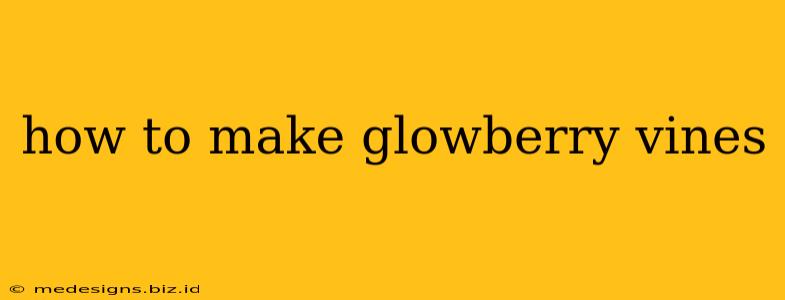Glowberry vines—those enchanting, luminous plants that add a magical touch to any garden or crafting project—are surprisingly easy to make! This guide provides a comprehensive, step-by-step approach, covering various techniques and materials to help you create your own glowing wonders. Whether you’re aiming for realistic-looking vines for a fantasy setting or whimsical decorations for a party, this guide has you covered.
Choosing Your Glowberry Materials
The key to realistic glowberries lies in selecting the right materials. Here's a breakdown of popular options and their pros and cons:
1. Using Polymer Clay: For Detailed and Durable Glowberries
Pros: Polymer clay offers incredible detail and durability. You can sculpt intricate shapes and achieve a realistic, textured look. Baked polymer clay is also long-lasting and can withstand handling.
Cons: Requires baking, adding time to the process. May require more advanced crafting skills for intricate designs.
2. Employing Glass Beads: An Easy and Elegant Choice
Pros: Glass beads are readily available in various sizes, colors, and finishes. They provide a beautiful, consistent glow, particularly if you choose luminescent or iridescent varieties. Assembly is relatively quick and easy.
Cons: May lack the organic look of sculpted berries. Careful selection is necessary to find beads that appropriately mimic glowberries.
3. Opting for Acrylic or Resin: Achieving Transparency and Shine
Pros: Acrylic or resin allows for creating transparent or translucent glowberries, offering a unique visual effect. You can incorporate glitter, pigments, or other decorative elements for added sparkle.
Cons: Requires more specialized tools and materials. Curing times can be significant, depending on the resin type.
Crafting Your Glowberry Vines: A Comprehensive Tutorial
Regardless of the material you choose, the basic steps for assembling your glowberry vines remain similar:
Step 1: Creating the Glowberries
- Polymer Clay: Roll small balls of clay, shaping them into slightly irregular berries. Add subtle details with sculpting tools for realism. Bake according to the clay manufacturer’s instructions.
- Glass Beads: Simply select beads of your desired size and color.
- Acrylic/Resin: Pour a small amount of acrylic or resin into molds (silicone molds work well). Add glitter or pigments if desired. Allow to cure completely.
Step 2: Constructing the Vine Base
Use flexible wire, floral wire, or even strong thread as the base for your vine. The thickness of the wire should correspond to the desired vine thickness. Consider using a natural-looking wire, like green-coated floral wire, to enhance the realism.
Step 3: Attaching the Glowberries to the Vine
Secure the glowberries to the vine using appropriate adhesive. Hot glue works well for polymer clay and glass beads, while a strong craft glue might be better suited for acrylic or resin berries. Space the berries along the vine, varying their positions for a natural look.
Step 4: Adding Finishing Touches
Once the glue is dry, consider adding additional details to enhance your glowberries and vines. This could include:
- Leaf additions: Attach small artificial leaves or create your own leaves using polymer clay or other materials.
- Texturing the vine: Wrap the vine with thin strips of fabric or twine to give it a more realistic texture.
- Adding Luminosity: If you are using non-luminous materials, consider adding small, battery-operated LED lights inside hollowed-out berries for an extra glow.
Tips for Realistic Glowberry Vines
- Vary berry sizes and colors: Real berries aren't uniformly sized or colored, so mimicking this variation will make your vines more believable.
- Add imperfections: Don't strive for perfect spheres. Slight imperfections and asymmetry add to the realism of your glowberries.
- Consider the vine's shape: Natural vines rarely grow in perfectly straight lines. Create gentle curves and bends for a more organic look.
With patience and creativity, you can create stunning, realistic-looking glowberry vines for your next project. Remember to experiment with different materials and techniques to find what works best for you and your creative vision. Happy crafting!
